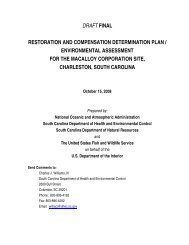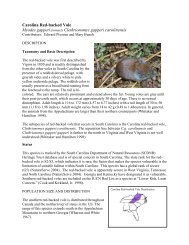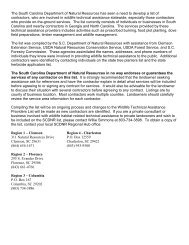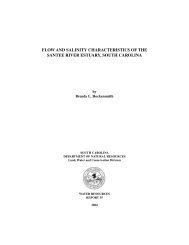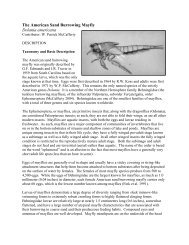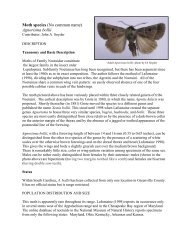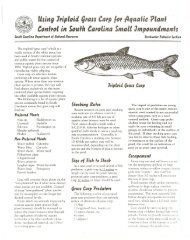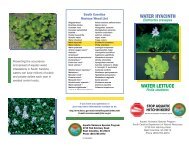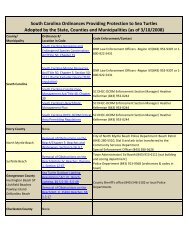Pond Management - South Carolina Department of Natural Resources
Pond Management - South Carolina Department of Natural Resources
Pond Management - South Carolina Department of Natural Resources
You also want an ePaper? Increase the reach of your titles
YUMPU automatically turns print PDFs into web optimized ePapers that Google loves.
Parasites and Diseases<br />
Parasites and diseases are common for fishes in warm <strong>South</strong><br />
<strong>Carolina</strong> waters. Infestations usually kill just a few fish at a time<br />
and generally present no major problem except to intensive<br />
commercial operations. The situation almost always corrects itself<br />
within a few weeks, and treatment is seldom practical, if even<br />
possible, for the average pond owner. The regional fishery biologist<br />
can <strong>of</strong>ten aid in identifying the problem and advise the best course<br />
<strong>of</strong> action.<br />
Muddy Water<br />
Turbidity prevents light penetration and prevents the growth <strong>of</strong><br />
beneficial phytoplankton, the base <strong>of</strong> the food chain in ponds.<br />
Fish can tolerate muddy water but growth is <strong>of</strong>ten compromised<br />
because food production has been impaired. Turbidity or muddy<br />
conditions are usually caused by run<strong>of</strong>f from unstabilized<br />
watersheds such as cropland, highway drainage, construction sites,<br />
etc. This can be prevented by using appropriate land use practices<br />
on the watershed, construction <strong>of</strong> diversion ditches or the use<br />
<strong>of</strong> silt fences. In excavated ponds, it is sometimes sufficient to<br />
construct a low berm or dike around the pond perimeter to slow<br />
down unwanted siltation. It is important to identify the source<br />
<strong>of</strong> the problem and to stabilize the area with vegetation or other<br />
means, otherwise the muddy conditions will continue following<br />
each rain event. If excess turbidity persists, it may be removed by<br />
the application <strong>of</strong> aluminum sulfate (filter alum) at the rate <strong>of</strong> 50<br />
lb. per acre-foot <strong>of</strong> water. The alum should be dissolved in water<br />
and quickly distributed over the entire pond surface, preferably by<br />
spraying. Application should be made during calm, dry weather<br />
and the water should be agitated as little as possible during and<br />
after application.<br />
In ponds with a total alkalinity below 20 mg/l (as is the case<br />
with many <strong>South</strong> <strong>Carolina</strong> ponds), alum treatment may lower the<br />
pH to dangerous levels. Hydrated lime (slaked lime or builder’s<br />
lime) applied at the same time at the rate <strong>of</strong> 30 lb. per acre-foot <strong>of</strong><br />
water will counteract undesirable acid formation. It is important<br />
24



